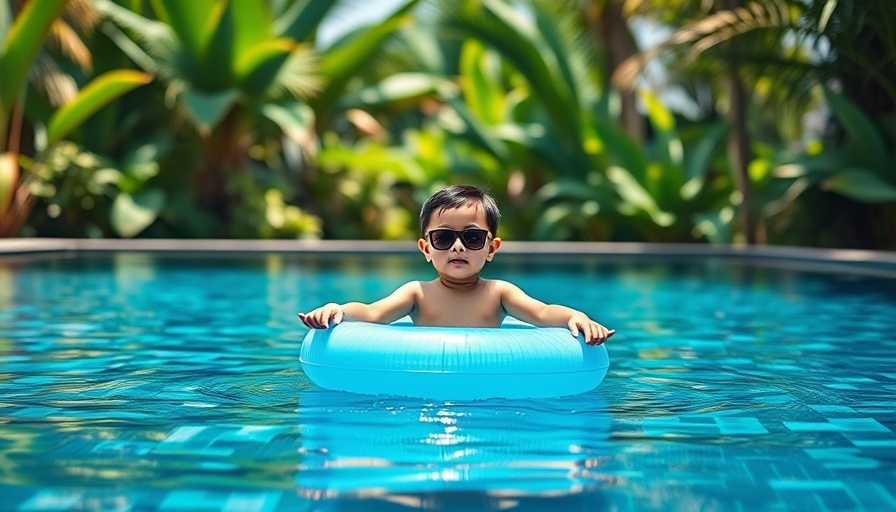
Embracing the Summer Challenge
As the days grow longer and the sun shines brighter, many parents face a dual challenge during the summer months: keeping their children engaged while managing their own mental well-being. With rising temperatures, children’s excitement levels peak, often leading to chaos and noise that can induce stress and feelings of anxiety, particularly for families navigating complex emotional landscapes. This summer, let’s explore how mindfulness and simple self-care routines can turn potential stressors into moments of joy, understanding, and connection.
Mindfulness: The Key to Calming Chaos
Mindfulness practices—where one focuses on the present moment without judgment—can significantly reduce anxiety symptoms and keep stress at bay. Integrating mindfulness into summer activities can foster a sense of calm for both children and parents. For instance, consider a morning yoga session in the backyard or a walk in nature where the kids can explore while learning to breathe mindfully. These activities can be both engaging and therapeutic.
Breathing Exercises: Simple and Effective
Breath control is fundamental to remaining centered in moments of heightened stress. You can involve your children in easy breathing exercises—like the 4-7-8 method. Instruct them to breathe in for four seconds, hold for seven, and exhale for eight. This not only calms anxiety but becomes a fun game. Practice this together, and watch as harmony unfolds amidst the typical summer hustle.
The Importance of Self-Care
For many caregivers and parents, self-care can often take a backseat. However, it is crucial, especially during summer months. Take time for yourself, whether it’s enjoying a quiet evening with a book, going for a short walk alone, or indulging in a favorite hobby. When you practice self-care, you set the tone for your family’s mental health, creating an environment where everyone feels validated and supported.
Coping Strategies for Children
Children, like adults, have their own struggles with mental health. Summer can trigger feelings of anxiety, especially with the abrupt changes in routine. This is where engaging in crafting or art can be therapeutic. Allowing your kids the space to express themselves creatively can foster resilience and emotional intelligence. Whether it’s drawing, painting, or making collages, these arts can become a part of your family’s mindful approach to summer.
The Role of Community and Connection
Another critical aspect of managing anxiety during summer is fostering social connections. Organizing playdates or community activities helps children feel less isolated, promoting emotional well-being. By connecting with other families, you reduce the stigma surrounding anxiety and mental health, cultivating a supportive network. Explore local events or consider joining community outreach programs focused on child and teenage mental health; it’s a win-win!
Community Outreach: Creating Support Networks
If the summer heat bears down, reach out for help. Resources like the SADAG helpline are invaluable for parents needing guidance regarding their children’s mental health. Not only can you gather advice on coping strategies, but sharing your experiences can also lessen the weight of your burden. Establishing a dialogue about mental health strengthens community bonds and educates everyone involved.
Creative Ways to Switch Up Routine
Routines are essential for both structure and peace of mind, but during summer, they can become monotonous. Introduce fun, spontaneous outings—like visiting an ice cream shop or exploring a new park. Such small changes keep engagement levels high and provide opportunities for relaxation and connection with your kids. Emphasizing laughter and adventures helps alleviate anxiety and fosters rich family memories.
Conclusion: Creating a Mindful Summer Experience
This summer, prioritize mindfulness and self-care to address the mental health challenges that can emerge. Embed breathing exercises into daily routines, make arts a therapy, and ensure to engage with communities with shared goals. By doing so, not only can we teach our children vital coping strategies, but we can also create an environment where families thrive together. Take a moment to reach out, explore new activities, and don’t forget to enjoy ice cream along the way. Together, let’s turn this summer into a blissful journey rather than a stressful endeavor!
As you engage with these practices, consider how you might support others within your community who may also be facing similar challenges. Let’s build bridges between families and create a network of care and mindfulness that permeates beyond the summer.
 Add Row
Add Row  Add
Add 




Write A Comment